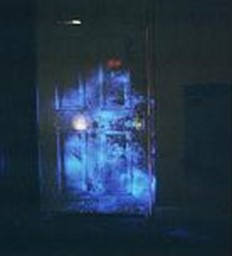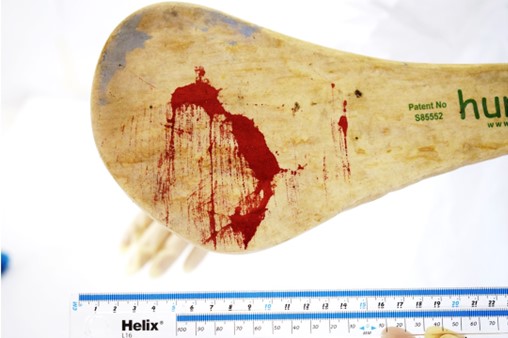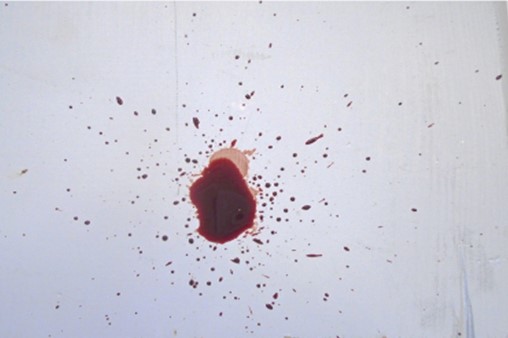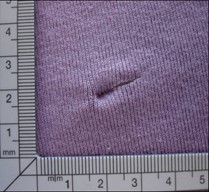Within the DNA section of FSI, there are scientists who specialise in the identification of various bodily fluids, including blood, saliva and semen. Obtaining DNA profiles from characterised bodily fluids can provide invaluable evidence in casework, particularly when the crimes are ‘crimes against the person’.
Biological Analysis
BLOOD ANALYSIS
Scientists at FSI utilise a number of tools to identify bloodstaining on items submitted as part of an investigation, including various different light sources and magnifying tools. Presumptive chemical tests are also used to indicate the presence of blood.
Chemi-luminescent presumptive testing is also carried out to determine if latent bloodstains are present at a scene or on clothing/weapons etc. BlueStar® Forensic test is a luminol-based chemi-luminescent test that is used to assist in the detection of blood at FSI. It is used in a range of scenarios including screening large areas for blood, detecting small or dilute bloodstains, bloodstains on dark or complex surface, latent bloodstaining and bloodstains that have been altered by possible cleaning. A positive reaction is observed when the Bluestar® reagent produces a distinct, long lasting, blue-white signal (chemiluminescence), visible in a darkened setting.

No bloodstaining was observed on a door at the scene of a murder. The murder had taken place months previously and the door had since been repainted.

When the same door was sprayed with a luminol-based reagent blood stains visible in a darkened setting.
Blood is a rich source of DNA but in some cases a DNA profile can’t be obtained from a sample. This may be because the blood is not human in origin. In such circumstance, a lateral flow chromatographic test, HemaTrace® is carried on a sample of the bloodstaining to determine if human haemoglobin is present or not.
In certain circumstances, bloodstaining can also be examined and categorised. Bloodstain Pattern Analysis (BPA) is a tool that is used for the interpretation of bloodstain patterns. When liquid blood is acted upon by physical forces, bloodstains and bloodstain patterns may be deposited or transferred onto various surfaces. By examining the size, shape, distribution and location of bloodstains, a trained analyst may be able to provide information concerning the events that lead to the creation of the bloodstain or bloodstain pattern. This information can be used to reconstruct a particular event, evaluate witness statements and help address particular scenarios

This image shows transfer staining in blood on the boss of a hurl. Transfer staining occurs when an object comes into contact with a source of wet blood. There is also percussive staining on the hurl. Percussive staining forms when a moving object that is wet with blood comes to sudden stop. This creates the feathering effect in blood observed on the hurl.

This image shows a drip pattern in blood. A drip pattern is formed when a stationary source of blood drips into another a liquid (which could also be blood). This impact creates secondary spatter stains the move up, out and away from central pool of blood that is formed. This drip pattern was created by allowing blood to drip continuously from a height.

This image shows a cast-off pattern in blood. A cast-off pattern is created when blood drops are released from an object due to motion. This staining was created by dipping a screwdriver in blood and swinging it at a wall three times. The blood was released from the screwdriver due to this motion and deposited as droplets on the wall along the trajectory of the moving screwdriver.
Other types of Analysis in this Category
SEMEN ANALYSIS
Victims of sexual crime are treated at Sexual Assault Treatment Units (SATU) located in in hospitals around the country, the first of which opened in 1985 at the Rotunda Hospital in Dublin. There are now SATU’s located in Cork, Limerick, Donegal, Waterford, Mullingar and Galway. At these units a variety of samples are taken including, blood, urine and a selection of intimate swabs forming a sexual assault kit. This kit along with the victims clothing and other items are submitted to the laboratory by An Garda Síochána. Further information on SATUs you can visit the HSE website
CLICK here
The presence of semen is indicated by presumptive chemical testing on a victims clothing and/or following the extraction of intimate swabs. The presence of spermatozoa is confirmed by microscopic examination of cells under high power magnification. Spermatozoa are not always present in the seminal fluid however, as is the case for vasectomised males. In such cases further tests are required.

Human spermatozoa are flagellated cells (they have tails). Cytological stains of spermatozoa are prepared which yield a characteristic oval shaped sperm head. In the top image, spermatozoa without tails are visible. In the bottom image, spermatozoa with tails are visible.

Other types of Analysis in this Category
SALIVA ANALYSIS
The identification of these body fluids are based on physical characteristics and chemical constituents. Chemical tests are used to confirm the presence of the constituents of saliva, urine and faeces. One such test is the RSID-Saliva™ kit which is a lateral flow chromatographic strip test designed to detect α – amylase, an enzyme present in human saliva. This test is carried out by extracting pieces of fabric or swabs in a buffered solution and then loading a specified amount of extracted solution to the sample well (as below). A similar test is now available for the detection of the constituents of urine.
Other types of Analysis in this Category
HAIR ANALYSIS
Hairs are screened and characterised using microscopy before they are further analysed. DNA profiling can then be carried out on characterised hairs. The success of DNA profiling from hairs is based on the amount of cellular material adhering to the hair.
Other types of Analysis in this Category
DAMAGE ANALYSIS
Clothing may be visually examined for the presence of damage. Assessing the characteristics of damage to clothing may help to determine the type of damage, the manner in which it was caused, whether it is recent or not and its significance. It may also be useful to corroborate the circumstances of a case. In rare cases, false allegations of assault are made; scientists may be able to differentiate between damage that is due to an assault and damage that has been fabricated to support an allegation.

The damage seen in this knitted fabric is an example of a stab cut.
